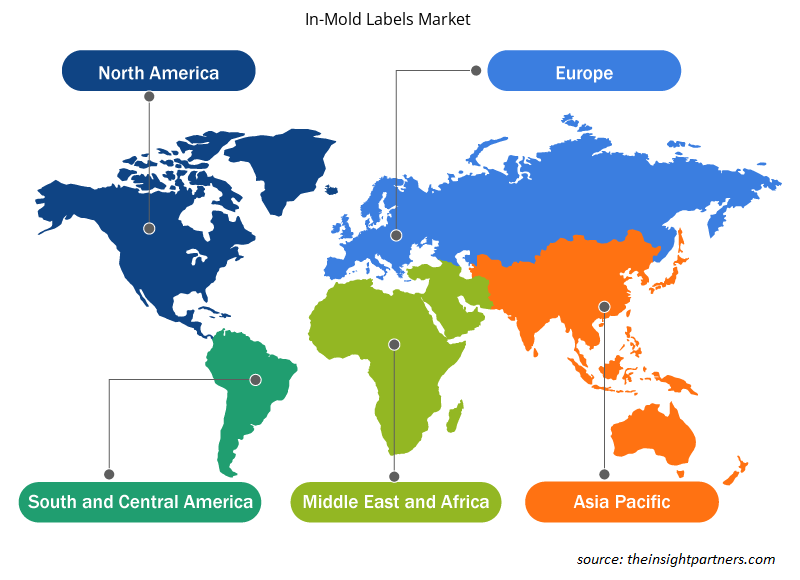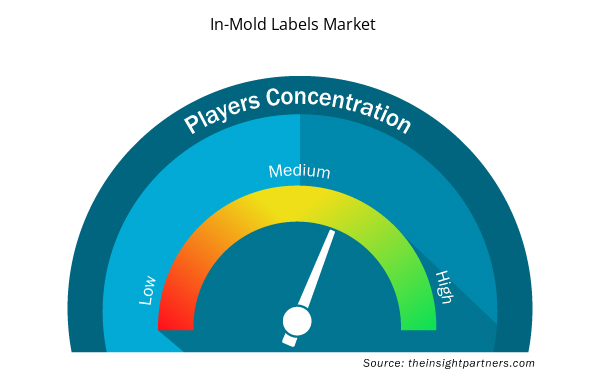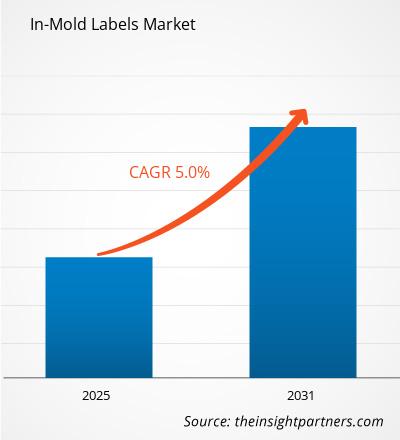Si prevede che il mercato delle etichette in-mold registrerà un CAGR del 5% dal 2023 al 2031, con una dimensione di mercato in espansione da XX milioni di dollari nel 2023 a XX milioni di dollari entro il 2031.
Il rapporto presenta analisi basate sul processo (soffiaggio, stampaggio a iniezione e termoformatura). Il rapporto è segmentato per tipo di materiale (polipropilene, HDPE, LDPE e altri). Il rapporto è segmentato per utente finale (cibo e bevande, cura della persona e cosmetici, automotive, beni di consumo e altri). L'analisi globale è ulteriormente suddivisa a livello regionale e nei principali paesi. Le dimensioni del mercato e le previsioni a livello globale, regionale e nazionale per tutti i principali segmenti di mercato sono coperte nell'ambito. Il rapporto offre il valore in USD per l'analisi e i segmenti di cui sopra. Il rapporto fornisce statistiche chiave sullo stato di mercato dei principali attori del mercato e offre tendenze e opportunità di mercato.
Scopo del rapporto
Il report In-Mold Labels Market di The Insight Partners mira a descrivere il panorama attuale e la crescita futura, i principali fattori trainanti, le sfide e le opportunità. Ciò fornirà spunti a vari stakeholder aziendali, come:
- Fornitori/produttori di tecnologia: per comprendere le dinamiche di mercato in evoluzione e conoscere le potenziali opportunità di crescita, consentendo loro di prendere decisioni strategiche informate.
- Investitori: condurre un'analisi completa delle tendenze relative al tasso di crescita del mercato, alle proiezioni finanziarie del mercato e alle opportunità esistenti lungo la catena del valore.
- Enti di regolamentazione: regolamentano le politiche e le attività di controllo sul mercato allo scopo di ridurre al minimo gli abusi, preservare la fiducia degli investitori e sostenere l'integrità e la stabilità del mercato.
Segmentazione del mercato delle etichette in-mold
Processo
- Stampaggio a soffiaggio
- Stampaggio a iniezione
- Termoformatura
Tipo di materiale
- Polipropilene
- PEAD
- Polietilene a bassa densità (LDPE)
Utente finale
- Cibo e bevande
- Cura della persona e cosmetici
- Automobilistico
- Beni di consumo
Geografia
- America del Nord
- Europa
- Asia-Pacifico
- America del Sud e Centro
- Medio Oriente e Africa
Geografia
- America del Nord
- Europa
- Asia-Pacifico
- America del Sud e Centro
- Medio Oriente e Africa
Personalizza questo report in base alle tue esigenze
Riceverai la personalizzazione gratuita di qualsiasi report, comprese parti di questo report, o analisi a livello nazionale, pacchetto dati Excel, oltre a usufruire di grandi offerte e sconti per start-up e università
- Scopri le principali tendenze di mercato in questo rapporto.Questo campione GRATUITO includerà analisi di dati che spaziano dalle tendenze di mercato alle stime e alle previsioni.
Fattori trainanti della crescita del mercato delle etichette in-mold
- Maggiore automazione nel processo di produzione: l'automazione nel processo di produzione sta alimentando notevolmente la crescita del mercato IML. I produttori utilizzeranno sempre più tecnologie automatizzate e, in tal modo, la precisione e la qualità dell'etichettatura saranno migliorate. Questa automazione aiuta a produrre con costi di manodopera minimi, minori possibilità di errori umani e, di conseguenza, migliora la qualità e l'uniformità dei prodotti nell'output finale.
- Aumento della velocità e flessibilità di produzione tramite automazione: inoltre, l'automazione consente cicli di produzione ad alta velocità, consentendo di soddisfare la domanda di imballaggi ad alto volume. L'applicazione delle tecniche IML nella robotica e nei macchinari avanzati può essere facilitata dal produttore, consentendo rapidi cambi da una linea di prodotti all'altra in un mercato competitivo con una preferenza dei consumatori in rapida evoluzione.
- Vantaggi di sostenibilità dell'etichettatura automatizzata in-mold nella produzione: i processi automatizzati migliorano ulteriormente la sostenibilità delle pratiche di produzione. L'etichettatura in-mold elimina gli sprechi derivanti dall'etichettatura tramite i vecchi metodi perché l'etichetta fa parte del prodotto una volta che è stata stampata. Il processo non solo risparmia il materiale ma anche l'energia; questa è una preoccupazione su cui sempre più aziende si sono concentrate, rendendo l'intera produzione ecosostenibile.
Tendenze future del mercato delle etichette in-mold
- Crescente attenzione alla sostenibilità: l'aspetto della sostenibilità sta crescendo rapidamente fino a diventare un fattore trainante di spicco nel mercato delle etichette in-mold. Le crescenti preferenze dei consumatori e delle aziende verso pratiche eco-compatibili stanno incoraggiando i produttori ad adottare soluzioni IML che supportano la riduzione al minimo degli sprechi e incoraggiano la riciclabilità. Ciò diventa una strada non solo per il miglioramento del marchio, ma anche per rispondere alle tendenze normative a favore di imballaggi ecocompatibili.
- Riduzione degli sprechi di materiali e degli imballaggi tramite la tecnologia IML: la tecnologia IML promuove la sostenibilità in quanto elimina l'uso di adesivi ed etichette in eccesso, il che implica una riduzione degli sprechi di materiali. L'uso di etichette nel processo di stampaggio elimina l'imballaggio in eccesso associato a tali prodotti, rendendoli così più leggeri e facili da trasportare. Questo risparmio di risorse è un grosso problema per le aziende che cercano di ridurre la propria impronta di carbonio.
- Substrati eco-compatibili innovativi ed etichettatura trasparente: inoltre, la crescita delle applicazioni IML in materiale biodegradabile e riciclabile migliora ulteriormente la sostenibilità dei cicli di vita dei prodotti. Utilizzando tali substrati eco-compatibili innovativi, i produttori ora stanno anche rispondendo alle esigenze dei consumatori attenti all'ambiente. A tale proposito, ciò sta influenzando il tipo di offerte fornite a una linea di prodotti e costringendo i marchi a costruire le proprie credenziali di sostenibilità con pratiche di etichettatura trasparenti.
Opportunità di mercato per le etichette in-mold
- Domanda crescente di imballaggi intelligenti: l'integrazione degli imballaggi intelligenti genererà anche immense prospettive di crescita nel mercato delle etichette in-mold. Combinando tecnologie come codici QR, NFC e RFID con soluzioni IML, i produttori potranno aumentare il coinvolgimento dei consumatori tramite l'interazione. Questa innovazione soddisfa un target group consapevole della tecnologia che aspira a maggiori informazioni e connettività.
- Migliorare la trasparenza della supply chain e la fiducia dei consumatori con le etichette intelligenti: le etichette intelligenti possono tracciare e seguire i prodotti con maggiore efficienza e trasparenza nelle supply chain. I marchi possono monitorare le loro scorte e prevenire qualsiasi adulterazione dei loro prodotti, che è una preoccupazione emergente oggi. Ciò aumenta ulteriormente la fiducia dei consumatori, risparmiando al contempo perdite da contraffazioni e frodi.
- Migliorare l'esperienza del consumatore con imballaggi intelligenti e dati in tempo reale: inoltre, gli imballaggi intelligenti offrono informazioni dettagliate sulla freschezza e le condizioni del prodotto in tempo reale. È possibile informare i consumatori sulla data di scadenza effettiva o su qualsiasi condizione di conservazione necessaria tramite l'integrazione di sensori in IML. Quindi, un'esperienza del consumatore migliorata porta alla fedeltà e ad acquisti ripetuti.
Approfondimenti regionali sul mercato delle etichette in-mold
Le tendenze regionali e i fattori che influenzano il mercato delle etichette in-mold durante il periodo di previsione sono stati ampiamente spiegati dagli analisti di Insight Partners. Questa sezione discute anche i segmenti e la geografia del mercato delle etichette in-mold in Nord America, Europa, Asia Pacifico, Medio Oriente e Africa e Sud e Centro America.

- Ottieni i dati specifici regionali per il mercato delle etichette in-mold
Ambito del rapporto di mercato sulle etichette in-mold
| Attributo del report | Dettagli |
|---|---|
| Dimensioni del mercato nel 2023 | XX milioni di dollari USA |
| Dimensioni del mercato entro il 2031 | XX milioni di dollari USA |
| CAGR globale (2023-2031) | 5% |
| Dati storici | 2021-2022 |
| Periodo di previsione | 2024-2031 |
| Segmenti coperti | Per processo
|
| Regioni e Paesi coperti | America del Nord
|
| Leader di mercato e profili aziendali chiave |
|
Densità dei player del mercato delle etichette in-mold: comprendere il suo impatto sulle dinamiche aziendali
Il mercato delle etichette In-Mold sta crescendo rapidamente, spinto dalla crescente domanda degli utenti finali dovuta a fattori quali l'evoluzione delle preferenze dei consumatori, i progressi tecnologici e una maggiore consapevolezza dei vantaggi del prodotto. Con l'aumento della domanda, le aziende stanno ampliando le loro offerte, innovando per soddisfare le esigenze dei consumatori e capitalizzando sulle tendenze emergenti, il che alimenta ulteriormente la crescita del mercato.
La densità degli operatori di mercato si riferisce alla distribuzione di aziende o società che operano in un particolare mercato o settore. Indica quanti concorrenti (operatori di mercato) sono presenti in un dato spazio di mercato in relazione alle sue dimensioni o al valore di mercato totale.
Le principali aziende che operano nel mercato delle etichette in-mold sono:
- Società per azioni CCL Industries, Inc.
- Cenveo Inc.
- Gruppo Constantia Flexibles GmbH
- Coveris Holdings SA 5 .EVCO Plastica
- Fuji Seal International, Inc.
Disclaimer : le aziende elencate sopra non sono classificate secondo un ordine particolare.

- Ottieni una panoramica dei principali attori del mercato delle etichette in-mold
Punti chiave di vendita
- Copertura completa: il rapporto esamina in modo completo i prodotti, i servizi, le tipologie e gli utenti finali del mercato delle etichette in-mold, fornendo una panoramica olistica.
- Analisi degli esperti: il rapporto è compilato sulla base della conoscenza approfondita di esperti e analisti del settore.
- Informazioni aggiornate: il rapporto garantisce la pertinenza aziendale grazie alla copertura di informazioni recenti e tendenze nei dati.
- Opzioni di personalizzazione: questo report può essere personalizzato per soddisfare le esigenze specifiche del cliente e adattarsi in modo appropriato alle strategie aziendali.
Il rapporto di ricerca sul mercato delle etichette In-Mold può quindi aiutare a guidare il percorso di decodifica e comprensione dello scenario del settore e delle prospettive di crescita. Sebbene possano esserci alcune preoccupazioni valide, i vantaggi complessivi di questo rapporto tendono a superare gli svantaggi.
- Analisi storica (2 anni), anno base, previsione (7 anni) con CAGR
- Analisi PEST e SWOT
- Valore/volume delle dimensioni del mercato - Globale, regionale, nazionale
- Industria e panorama competitivo
- Set di dati Excel


- Transdermal Drug Delivery System Market
- Emergency Department Information System (EDIS) Market
- Clinical Trial Supplies Market
- Fertilizer Additives Market
- Vertical Farming Crops Market
- Playout Solutions Market
- Analog-to-Digital Converter Market
- Precast Concrete Market
- Drain Cleaning Equipment Market
- Microplate Reader Market

Report Coverage
Revenue forecast, Company Analysis, Industry landscape, Growth factors, and Trends

Segment Covered
This text is related
to segments covered.

Regional Scope
North America, Europe, Asia Pacific, Middle East & Africa, South & Central America

Country Scope
This text is related
to country scope.
Domande frequenti
The growing focus on sustainable practices is expected to be the key market trends.
Based on geography, Asia Pacific held the largest share of the in-mold labels market due to rapid industrialization and urbanization in countries such as China and India have led to increased demand for packaged goods. This surge in consumer products drives the need for efficient and visually appealing labeling solutions.
Based on process, the injection molding segment is expected to witness the fastest growth during the forecast period
Automation in manufacturing processes are driving the market growth.
CCL Industries Inc.; Constantia Flexibles Group GmbH; Coveris Holding S.A.; Avery Dennison Corp.; Multicolor Corporation; Fuji Seal International Inc.; Huhtamaki Oyj; Korsini Ambalaj San. Tic. A.S.; Canyon Graphics; and Aspasie are some of the key players operating in the in-mold labels market
The In-Mold Labels Market is estimated to witness a CAGR of 5% from 2023 to 2031
Trends and growth analysis reports related to Chemicals and Materials : READ MORE..
1. CCL Industries, Inc.
2. Cenveo Inc.
3. Constantia Flexibles Group GmbH
4. Coveris Holdings S.A.
5 .EVCO Plastics
6. Fuji Seal International, Inc.
7. Huhtamaki Group
8. Inland Label and Marketing Services, LLC
9. Innovia Films Ltd.
10. Multicolor Corporation
The Insight Partners performs research in 4 major stages: Data Collection & Secondary Research, Primary Research, Data Analysis and Data Triangulation & Final Review.
- Data Collection and Secondary Research:
As a market research and consulting firm operating from a decade, we have published and advised several client across the globe. First step for any study will start with an assessment of currently available data and insights from existing reports. Further, historical and current market information is collected from Investor Presentations, Annual Reports, SEC Filings, etc., and other information related to company’s performance and market positioning are gathered from Paid Databases (Factiva, Hoovers, and Reuters) and various other publications available in public domain.
Several associations trade associates, technical forums, institutes, societies and organization are accessed to gain technical as well as market related insights through their publications such as research papers, blogs and press releases related to the studies are referred to get cues about the market. Further, white papers, journals, magazines, and other news articles published in last 3 years are scrutinized and analyzed to understand the current market trends.
- Primary Research:
The primarily interview analysis comprise of data obtained from industry participants interview and answers to survey questions gathered by in-house primary team.
For primary research, interviews are conducted with industry experts/CEOs/Marketing Managers/VPs/Subject Matter Experts from both demand and supply side to get a 360-degree view of the market. The primary team conducts several interviews based on the complexity of the markets to understand the various market trends and dynamics which makes research more credible and precise.
A typical research interview fulfils the following functions:
- Provides first-hand information on the market size, market trends, growth trends, competitive landscape, and outlook
- Validates and strengthens in-house secondary research findings
- Develops the analysis team’s expertise and market understanding
Primary research involves email interactions and telephone interviews for each market, category, segment, and sub-segment across geographies. The participants who typically take part in such a process include, but are not limited to:
- Industry participants: VPs, business development managers, market intelligence managers and national sales managers
- Outside experts: Valuation experts, research analysts and key opinion leaders specializing in the electronics and semiconductor industry.
Below is the breakup of our primary respondents by company, designation, and region:

Once we receive the confirmation from primary research sources or primary respondents, we finalize the base year market estimation and forecast the data as per the macroeconomic and microeconomic factors assessed during data collection.
- Data Analysis:
Once data is validated through both secondary as well as primary respondents, we finalize the market estimations by hypothesis formulation and factor analysis at regional and country level.
- Macro-Economic Factor Analysis:
We analyse macroeconomic indicators such the gross domestic product (GDP), increase in the demand for goods and services across industries, technological advancement, regional economic growth, governmental policies, the influence of COVID-19, PEST analysis, and other aspects. This analysis aids in setting benchmarks for various nations/regions and approximating market splits. Additionally, the general trend of the aforementioned components aid in determining the market's development possibilities.
- Country Level Data:
Various factors that are especially aligned to the country are taken into account to determine the market size for a certain area and country, including the presence of vendors, such as headquarters and offices, the country's GDP, demand patterns, and industry growth. To comprehend the market dynamics for the nation, a number of growth variables, inhibitors, application areas, and current market trends are researched. The aforementioned elements aid in determining the country's overall market's growth potential.
- Company Profile:
The “Table of Contents” is formulated by listing and analyzing more than 25 - 30 companies operating in the market ecosystem across geographies. However, we profile only 10 companies as a standard practice in our syndicate reports. These 10 companies comprise leading, emerging, and regional players. Nonetheless, our analysis is not restricted to the 10 listed companies, we also analyze other companies present in the market to develop a holistic view and understand the prevailing trends. The “Company Profiles” section in the report covers key facts, business description, products & services, financial information, SWOT analysis, and key developments. The financial information presented is extracted from the annual reports and official documents of the publicly listed companies. Upon collecting the information for the sections of respective companies, we verify them via various primary sources and then compile the data in respective company profiles. The company level information helps us in deriving the base number as well as in forecasting the market size.
- Developing Base Number:
Aggregation of sales statistics (2020-2022) and macro-economic factor, and other secondary and primary research insights are utilized to arrive at base number and related market shares for 2022. The data gaps are identified in this step and relevant market data is analyzed, collected from paid primary interviews or databases. On finalizing the base year market size, forecasts are developed on the basis of macro-economic, industry and market growth factors and company level analysis.
- Data Triangulation and Final Review:
The market findings and base year market size calculations are validated from supply as well as demand side. Demand side validations are based on macro-economic factor analysis and benchmarks for respective regions and countries. In case of supply side validations, revenues of major companies are estimated (in case not available) based on industry benchmark, approximate number of employees, product portfolio, and primary interviews revenues are gathered. Further revenue from target product/service segment is assessed to avoid overshooting of market statistics. In case of heavy deviations between supply and demand side values, all thes steps are repeated to achieve synchronization.
We follow an iterative model, wherein we share our research findings with Subject Matter Experts (SME’s) and Key Opinion Leaders (KOLs) until consensus view of the market is not formulated – this model negates any drastic deviation in the opinions of experts. Only validated and universally acceptable research findings are quoted in our reports.
We have important check points that we use to validate our research findings – which we call – data triangulation, where we validate the information, we generate from secondary sources with primary interviews and then we re-validate with our internal data bases and Subject matter experts. This comprehensive model enables us to deliver high quality, reliable data in shortest possible time.


 Ottieni un campione gratuito per questo repot
Ottieni un campione gratuito per questo repot